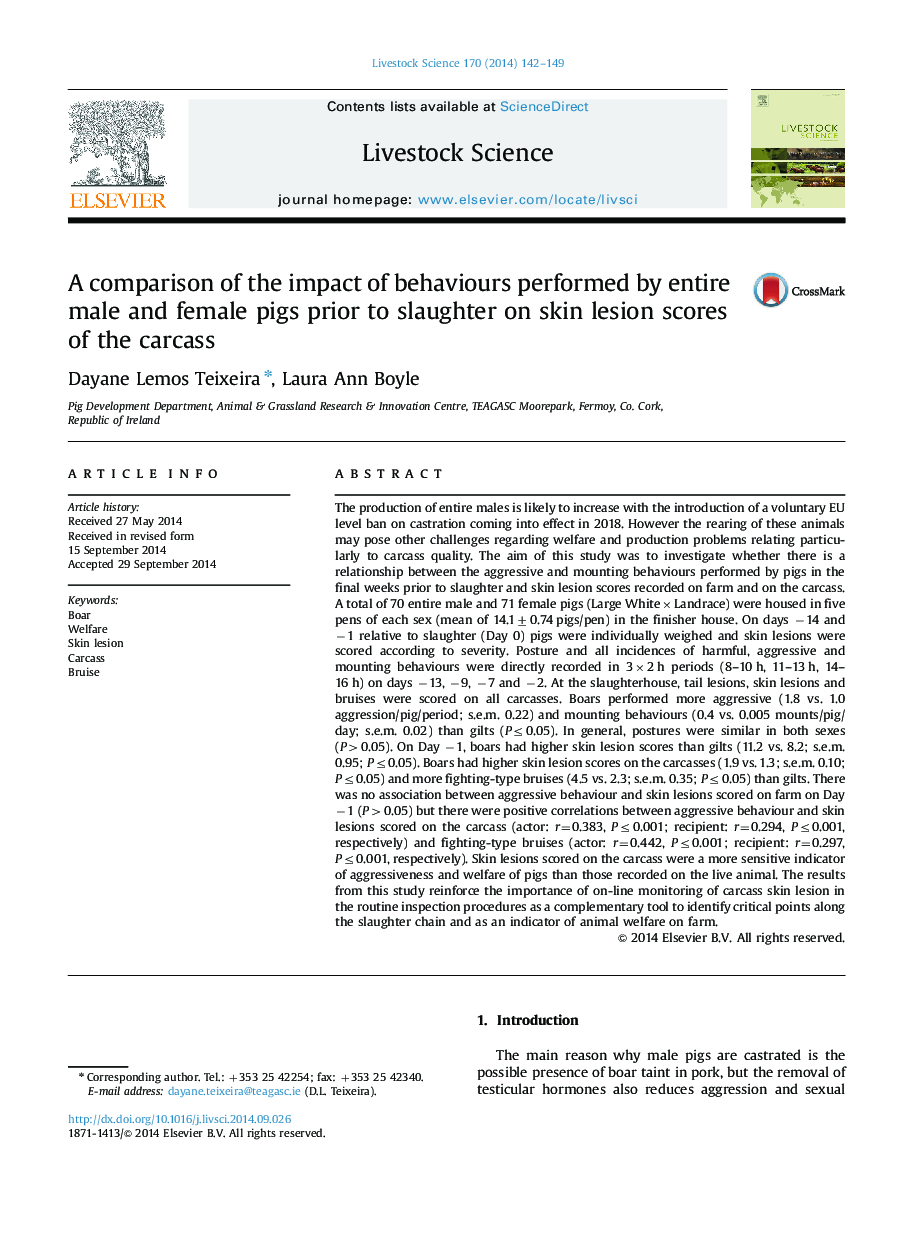| کد مقاله | کد نشریه | سال انتشار | مقاله انگلیسی | نسخه تمام متن |
|---|---|---|---|---|
| 2447176 | 1553962 | 2014 | 8 صفحه PDF | دانلود رایگان |
• We studied the behaviour of entire male and female pigs in single sex groups.
• We examined how the behaviour affects the skin lesions of the pigs.
• Entire males performed more aggressions and mounts than female pigs.
• Entire males presented higher skin lesion scores as a consequence of their behaviour.
• Carcass lesion score is a sensitive indicator of aggressiveness and welfare of pigs.
The production of entire males is likely to increase with the introduction of a voluntary EU level ban on castration coming into effect in 2018. However the rearing of these animals may pose other challenges regarding welfare and production problems relating particularly to carcass quality. The aim of this study was to investigate whether there is a relationship between the aggressive and mounting behaviours performed by pigs in the final weeks prior to slaughter and skin lesion scores recorded on farm and on the carcass. A total of 70 entire male and 71 female pigs (Large White×Landrace) were housed in five pens of each sex (mean of 14.1±0.74 pigs/pen) in the finisher house. On days −14 and −1 relative to slaughter (Day 0) pigs were individually weighed and skin lesions were scored according to severity. Posture and all incidences of harmful, aggressive and mounting behaviours were directly recorded in 3×2 h periods (8–10 h, 11–13 h, 14–16 h) on days −13, −9, −7 and −2. At the slaughterhouse, tail lesions, skin lesions and bruises were scored on all carcasses. Boars performed more aggressive (1.8 vs. 1.0 aggression/pig/period; s.e.m. 0.22) and mounting behaviours (0.4 vs. 0.005 mounts/pig/day; s.e.m. 0.02) than gilts (P≤0.05). In general, postures were similar in both sexes (P>0.05). On Day −1, boars had higher skin lesion scores than gilts (11.2 vs. 8.2; s.e.m. 0.95; P≤0.05). Boars had higher skin lesion scores on the carcasses (1.9 vs. 1.3; s.e.m. 0.10; P≤0.05) and more fighting-type bruises (4.5 vs. 2.3; s.e.m. 0.35; P≤0.05) than gilts. There was no association between aggressive behaviour and skin lesions scored on farm on Day −1 (P>0.05) but there were positive correlations between aggressive behaviour and skin lesions scored on the carcass (actor: r=0.383, P≤0.001; recipient: r=0.294, P≤0.001, respectively) and fighting-type bruises (actor: r=0.442, P≤0.001; recipient: r=0.297, P≤0.001, respectively). Skin lesions scored on the carcass were a more sensitive indicator of aggressiveness and welfare of pigs than those recorded on the live animal. The results from this study reinforce the importance of on-line monitoring of carcass skin lesion in the routine inspection procedures as a complementary tool to identify critical points along the slaughter chain and as an indicator of animal welfare on farm.
Journal: Livestock Science - Volume 170, December 2014, Pages 142–149
